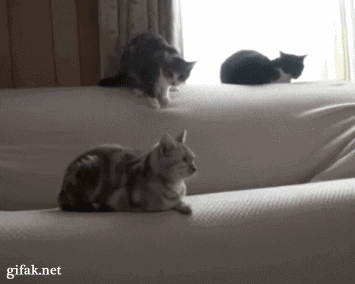Another post from two other students, Dre and John, in my Experimental Ecology class. Their research involved watching the behaviors of interacting dogs at dog parks. Enjoy their guest post below!
We are currently undergraduate students at San Diego State studying biology. We wanted to choose an ecological area of research that would relate to many people so we chose to study man’s best friend. Dogs hold a valuable place in society as they are not only emotional healers but they greatly assist in many duties humans could not do. Understanding the behaviors of canines will give insight to how not only these animals interact, but how other mammals show their dominance. There has long been comparison between humans and dogs so choosing this subject seemed to greatly compliment our research.
 |
| http://happyherbivore.com/2010/12/vegan-paleo/ |
Social dominance is a well-displayed behavior in many mammals. Through our research, we determined that there are many traits that can influence canine aggressiveness. Some of these traits exhibited by canines are very similar to those shown in humans. People have long wondered if traits in humans are related to traits in other mammals, including dogs. Well, we found that there are many common behavioral traits between both species.
 |
| http://lifeboat.com/images/couple.shouting.jpg |
Vocal Tone:
Humans display dominance over others through conversation, attitude, and conflict. Some of these traits in humans are similar to those shown in canines. For example, humans show dominance in their vocal pitch (Keating 1985). Keating suggests that the tone in male voices reflects the dominance they display over others. Those with lower vocal tones tend to express more dominant behavior over those with higher pitched vocal tones. Even within social interaction between males, you can notice different aggression types between different vocal pitches. This behavior is very similar to the social dominance exhibited in canines. According to Bradshaw et. al. (1985), canines show dominance through barking and growling. The tone of growling dictates the amount of aggression one dog displays over another. Those canines that have louder toned barks such as Mastiffs are observed to display stronger dominance over dogs with lower toned barks such as Chihuahua’s. Vocal tone is one of the many types of dominant indicators that numerous mammals have in common. |
| http://makeusknow.com/images/why-do-dogs-bark.jpg |
Appearance:
Another way that dominance can be compared in canines and humans is by way of appearance. Appearance in both species is very important during social interactions. Appearance in dogs is based on their breed while appearance in humans varies by many factors including ethnicity. According to Waring et. al. (2013), dominance within humans is displayed differently based on their ethnicity and background. They state that people exhibit different behavioral dominance based on their heritage and ethnic background. Those who grow up in cultures where households are predominantly conservative show significantly less dominant behavior than those who grow up in nonconservative households. For example, they show that people of Asian backgrounds tend to exhibit less dominant behavior due to their upbringing. Dominant behavior between humans can be related to dominating conversation, controlling day plans, and loud vocal tone. Varying dominance among ethnic social groups is very similar to the varying dominance seen among canine breeds. More aggressive breeds such as Boxers and Pit Bulls often show dominance over submissive dogs such as Golden Retrievers and Cocker Spaniels(Guisado and Munoz 2009). Though varied dominance seen within different ethnicities is mainly based on social background rather than appearance, there still exists a relationship between appearance and dominance in both humans and canines. |
| http://www.imagesbuddy.com/img/dogs/page/17/ |
So, are all men dogs?
Well, no. However, there is definitely something to be said about how humans, including females, exhibit their dominance over others in certain situations. Through our own observational study, there were definitely times when we saw similarities to how dogs interact and how humans interact. Even without words, dogs give off a personality about them that can be noticed. Some dogs are more investigative while others just want to be by themselves. In certain respects, humans are very similar to dogs.Our Research:
Our research looked into whether certain physical traits correlated to dominance among dog breeds. We hypothesized that larger dogs and male dogs would be the most dominant. In order to determine each sampled dogs level of dominance, we recorded five behavioral traits including urination, stance, growling, tail activity, and rolling on back while observing interacting dogs in a dog park. We used a principal component analysis (PCA) to compile all 5 behavioral variables into one measure of dominance. We then looked at whether dogs of different sizes or sexes differed in this measure of dominance. However, our study concluded that there was no significant differences in the average dominance between male and female dogs, and among small, medium, and large dogs. These findings, even though do not support our initial hypotheses, are also seen in many other canine studies. Many researches claim that they too do not find any relationship between size and sex and dominance in canines.We hope to compare our research with other ecologists who have conducted similar studies and have noticed similar behavioral patterns. In future studies, we will greatly increase our sample size and focus on just a few breeds of canine. We intend to continue research in this field as we both have strong interests.
-----------------
Contact Information:
Diandre Labadie: dlabadie@rohan.sdsu.edu
John Bruner: jmbruner37@aol.com
Sources:
Keating,C. 1985. Human dominance signals: the primate in us. Spring Series in Social Psychology 32: 89108.
Bradshaw, J. W. S., E. J. Blackwell, and R. A. Casey. 2009. Dominance in dogs useful or constructive? Journal of Veterinary Behavior 4: 135144.
Waring, T. M., and A. V. Bell. 2013. Ethnic dominance damages cooperation more than ethnic diversity: results from multiethnic field experiments in India. Evolution and Human Behavior 34: 398404.
Perez Guisado, J., and A. Munoz Serrano. 2009. Factors linked to dominance aggression in dogs. Journal of Animal and Veterinary Advances. 8: 336342.






.jpg)

























